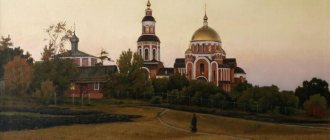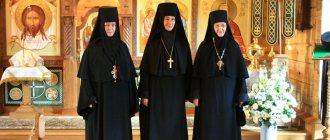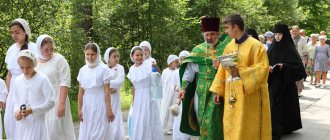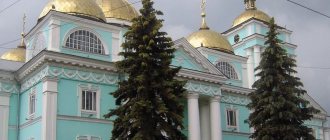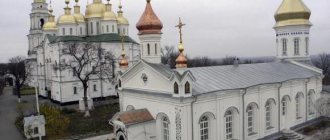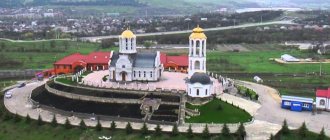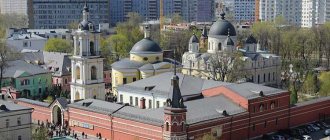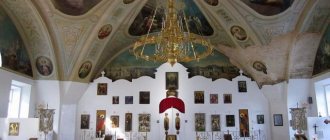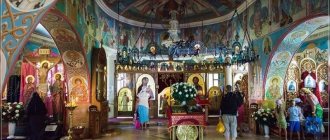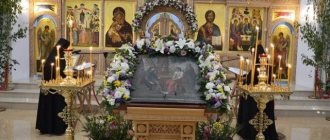Mir
Russia Tomsk Region Tomsk Mother of God-Alexievsky Monastery (Tomsk) Map is loading…
{"format":"leaflet","minzoom":false,"maxzoom":false,"limit":50,"offset":0,"link":"all","sort":[""], "order":[],"headers":"show","mainlabel":"","intro":"","outro":"","searchlabel":"\u2026 \u0441\u043b\u0435\ u0434\u0443\u044e\u0449\u0438\u0435 \u0440\u0435\u0437\u0443\u043b\u044c\u0442\u0430\u0442\u044b","default":"","import-annotation":false,"width ":"auto","height":"350px","centre":{"text":"","title":"""link":"""lat":56.48188900000000245427145273424685001373291015625,"lon": 84.9550760000000053651092457585036754608154296875,"icon":""},"title":"","label":"","icon":"","lines":[],"polygons":[],"circles":[ ],"rectangles":[],"copycoords":false,"static":false,"zoom":8,"defzoom":14,"layers":["OpenStreetMap"],"image layers":[] ,"overlays":[],"resizable":false,"fullscreen":true,"scrollwheelzoom":true,"cluster":false,"clustermaxzoom":9,"clusterzoomonclick":true,"clustermaxradius":80, "clusterspiderfy":true,"geojson":"","clicktarget":"","showtitle":true,"hidenamespace":false,"template":"","userparam":"","activeicon": "","pagelabel":false,"ajaxcoordproperty":"","ajaxquery":"","locations":[{"text":"\u003Cb\u003E\u003Ca href=\"/palomnik/%D0% 91%D0%BE%D0%B3%D0%BE%D1%80%D0%BE%D0%B4%D0%B8%D1%86%D0%B5-%D0%90%D0%BB%D0%B5 %D0%BA%D1%81%D0%B8%D0%B5%D0%B2%D1%81%D0%BA%D0%B8%D0%B9_%D0%BC%D1%83%D0%B6%D1 %81%D0%BA%D0%BE%D0%B9_%D0%BC%D0%BE%D0%BD%D0%B0%D1%81%D1%82%D1%8B%D1%80%D1%8C_ (%D0%A2%D0%BE%D0%BC%D1%81%D0%BA)\" title=\"\u0411\u043e\u0433\u043e\u0440\u043e\u0434\u0438\u0446\u0435-\ u0410\u043b\u0435\u043a\u0441\u0438\u0435\u0432\u0441\u043a\u0438\u0439 \u043c\u0443\u0436\u0441\u043a\u043e\u0439 \u043c\u0 43e\u043d\u0430\u0441\u0442\ u044b\u0440\u044c (\u0422\u043e\u043c\u0441\u043a)\»\u003E\u0411\u043e\u0433\u043e\u0440\u043e\u0434\u0438\u0446\u0435-\u0410 \u043b\u0435\u043a \u0441\u0438\u0435\u0432\u0441\u043a\u0438\u0439 \u043c\u0443\u0436\u0441\u043a\u043e\u0439 \u043c\u043e\u043d\u0430\u0441\ u0442\u044b\u0440\u044c (\ u0422\u043e\u043c\u0441\u043a)\u003C/a\u003E\u003C/b\u003E\u003Chr /\u003E\u003Ca href=\"/palomnik/%D0%A1%D0%B2%D0%BE%D0 %B9%D1%81%D1%82%D0%B2%D0%BE:%D0%90%D0%BD%D0%BD%D0%BE%D1%82%D0%B0%D1%86%D0% B8%D1%8F\" title=\"\u0421\u0432\u043e\u0439\u0441\u0442\u0432\u043e:\u0410\u043d\u043d\u043e\u0442\u0430\u0446\u0438\u044f\"\u003 E > 2\u043d\u044b\u0439\ u043c\u0443\u0436\u0441\u043a\u043e\u0439 \u043c\u043e\u043d\u0430\u0441\u0442\u044b\u0440\u044c \u0432 \u0422\u043e\u043c\u 0441\u043a\u043e\u0439\u043e\ u0431\u043b\u0430\u0441\u0442\u0438. XVII \u0432\u0435\u0 43a\u0430. \u041c\u043e\u043d\u0430\u0441\u0442\u044b\u0440\u044c \u0431\u044b\u043b \u0437\u0430\u043a\u0440\u044b\u0442 \u0441\u043e \u0432\u0435\u0442\u0441\u043a 1922 0\u0430\u0449\u0435\u043d\u0426 \u0435\u0440\u043a\u0432\u0438 \u0432 1992 \u0433. \u041f\u0440\u0438 \u043c\u043e\u043d\u0430\u0441\u0442\u044b\u0440\u0435 \u0434\u0435\u0439\u0441\u0442\u0432\u0443\u0435\ u0442\u0442\u0440\u0430\u043f \u0435\u0437\u043d\u0430\u044f \u0438 \u0433\u043e\u0441\u0442\u0438\u043d\u0438\u0446\u0430 \u0434\u043b\u044f \u043f\u043 0\u043b\u043e\u043c\u043d\u0438 \u043a\u043e\u0432.","title":"\u0411\u043e\u0433\u043e\u0440\u043e\u0434\u0438\u0446\u0435-\u0410\u043b\u0435\u043a\u0441\u0438\ u0435\ u0432\u0441\u043a\u0438\u0439 \u043c\u0443\u0436\u0441\u043a\u043e\u0439 \u043c\u043e\u043d\u0430\u0441\u0442\u044b\u0440\u0 44c (\u0422\u043e\u043c\u0441 \u043a)","link":"","lat":56.48188900000000245427145273424685001373291015625,"lon":84.9550760000000053651092457585036754608154296875, "icon":""}],"imageLayers":[]}
56.481892; 84.95515
Russia, Tomsk, Krylova street, 12B
Tomsk, Tomsk region 634050
Russia
Telephones:
(3822) 53–14–45; (3822) 52–74–23
Email:
,
Theotokos-Alexievsky Monastery
- Orthodox male monastery in the Tomsk region. It was founded at the beginning of the 17th century. The monastery was closed by the Soviet authorities in 1922 and returned to the Church in 1992. The monastery has a refectory and a hotel for pilgrims.
History[edit]
St. rights Fedor Tomsky
Information about the time when the monastery was founded differs - according to some sources it was founded in 1605, according to others - in 1622. It is known that the monastery definitely existed in the 1630s. A. Latyshev explains such an early appearance of the monastery in the newly founded city by government decrees, and not by a large number of potential inhabitants who dream of moving away from the world. The original population of Tomsk consisted of riotous Cossacks, self-interested industrialists, foreign seekers of wealth, exiled Poles, exiled convicts, local Tatars, “whose customs pleased the Russians, and polygamy found imitators.” “The government saw how necessary a pious institution was in such a region, setting an example of Christian virtues...”
In the 1630-1650s, the Bogoroditsky Monastery was located at the confluence of the Kirgizka River with the Tom (Ust-Kirgiz Monastery). In 1658 it was moved to Yurt Mountain. During construction, underground warehouses and passages to the Ushaika River were built (workers who were doing excavation work stumbled upon the brick vault in early November 1888 in the courtyard of the head of the Tomsk treasury chamber, V.B. Orlov, who lived at the end of the street stretching from the monastery fence to the Ushaika River) .
In 1663, the church was consecrated in the name of St. Alexei, the man of God, and the monastery began to be called the Mother of God-Alekseevsky.
The management of the other eight Siberian monasteries that were part of the Tomsk category was carried out from the Mother of God-Alekseevsky Monastery. Until 1764, the monastery was the only owner of 400 serfs in the Tomsk province, and also owned land on the Tom and Ob rivers. In the 17th century, a hospital was opened at the monastery, and in 1746 the first Tomsk school was the Tomsk Russian Theological School (in 1762 it was transformed into a Russian-Latin school). Also, since 1858, a theological seminary with an extensive library operated at the monastery.
The monastery, like other Siberian monasteries, was a place of exile for violators of monastic regulations. It also contained secular persons.
The main monastery church is the Kazan Church, which also has chapels in honor of Alexy, the man of God and saints Florus and Laurus. The building was originally made of wood and burned down several times. In 1789, a modern stone church building was built in the Siberian Baroque style. In the church there was a particularly revered image of the Mother of God “The Burning Bush”.
In the 1830s, the monastery was surrounded by stone walls and chapel towers (designed by Tomsk architect K. G. Tursky). On the territory there was a garden, a lake, summer cells and a cemetery, and to the south of the monastery there was a monastery grove, which remained until the beginning of the 20th century.
In 1922, the monastery itself was closed, but the community of believers at the Kazan Church existed until 1929. During this period, the monks lived under arrest in the fraternal building, and after the closure of the temple, together with the archimandrite, they were executed on Mount Kashtak.
In 1930, the Industrial Pedagogical Institute was located on the premises of the monastery.
By decision of the Tomsk Regional Executive Committee of February 17, 1978, the complex of monastery buildings was taken under state protection.
In 1992, the Kazan Church and the cell building of the monastery were returned to the believers. Regular worship began. On July 5, 1995, in a cesspool on the site of the destroyed chapel of Fyodor Kuzmich, his relics were found, which became the main monastery relic. In 1997, the chapel of the saint was restored.
In 2010, in the cell building of the monastery (the former building of the bishop's house, built in 1835 on the southern side of the monastery fence), the house church of the Three Saints was consecrated. It houses a marble iconostasis; the decor of the church itself is made in the Byzantine style.
In 2012, 15 million rubles were allocated from the federal budget under the Russian Culture program for the restoration of the Kazan Church.
Temples
Kazan Temple
The stone church was founded in 1776 with the blessing of St. Varlaam (Petrov), Archbishop of Tobolsk and all Siberia. In 1779, the side chapels of the temple were consecrated, dedicated to the holy martyrs Florus and Laurus (northern) and St. Alexis the man of God (southern). And only 10 years later, in 1789, the main altar was consecrated in honor of the Kazan Icon of the Mother of God.
The church bell tower, built in 1860, became the true decoration of the monastery. In 1863, the “Solemn” 303-pound bell was raised on it. At first, they wanted to place a throne in the name of St. in the second tier of the bell tower. right Lazarus the Four-Day, but later the archive and repository of antiquities of the monastery were built here.
After the closure of the monastery, the temple continued to function as a parish church. On December 17, 1929, by decision of the Siberian Regional Executive Committee in Tomsk, the church was closed. Over time, it was partially dismantled.
In the early 1980s, the temple, according to local newspaper correspondents, was “... the stump of an ancient building with the remains of a dome.” By the time the reconstruction of the monastery began at the end of the century, the bell tower, apse, and the completion and covering of the temple itself had not been preserved.
In the early 1990s, large-scale restoration work was carried out, as a result of which the temple was completely restored.
| Chapel is right. Theodore of Tomsk, Mother of God-Alekseevsky Monastery in Tomsk, beginning. XX century |
Chapel of St.
Theodore of Tomsk In 1904, over the grave of the popularly revered elder St. Theodore, located according to his will in the monastery fence, a stone chapel was built. The main chapel icon depicted St. blgv. book Alexander Nevsky is the heavenly patron of Emperor Alexander I and St. Theodore Stratilates is the patron saint of the elder Theodore Kuzmich.
In Soviet times, it was dismantled into bricks for the construction of secular buildings.
In 1997 - 1998, the chapel-monument was restored according to the original design on the previous foundations.
Church of the Three Saints
Built at the end - beginning of the 21st century.
Gate Temple
Built at the end of the 20th - beginning of the 21st century.
Shrines[edit]
- The relics of the holy righteous elder Theodore of Tomsk, in the Alexievsky chapel of the monastery church
- Kazan Icon of the Mother of God, purchased from one of the Moscow collectors, transferred to the monastery in November 2004
- The icon of St. Alexis the Man of God with a particle of his relics lies on the analogue in the right aisle of the monastery church. The icon was painted by Tomsk icon painter Yuri Rodionov, a particle of the relics was transferred to the monastery by one of the Moscow churches
- Ark with particles of the relics of the 12 Optina elders
- Ark with particles of the relics of twenty saints: John the Baptist, Lazarus of the Fourth Day, smch. Ignatius the God-Bearer, martyr. Euphemia of All Praise, St. Theodosius of Chernigov, Nikita of Novgorod, Tikhon and Mitrofan of Voronezh, Dmitry of Rostov, Philaret of Moscow, Innocent of Moscow, Venerable. Job Pochaevsky, Nil Stolobensky, blessed. Vasily Christ for the sake of the holy fool and Matrona of Moscow, the blessed prince Oleg Bryansky, the righteous Artemy Verkolsky and Simeon Verkhotursky
- Icon with the relics of St. Basil the Great, Gregory the Theologian and John Chrysostom
- Newly painted icon of the Life-Giving Trinity, which revealed the miracle of the flow of myrrh during Great Lent 2004
Shrines and patronal feasts
The modern Alekseevsky Convent, officially revived in 2013, is famous for its many miraculous icons and holy relics, thanks to which miracles and miracles of healing occur in the monastery.
The restored church was consecrated with the miraculous copy of the Mother of God “The All-Tsarina,” which was brought from Mount Athos. Nowadays parishioners and pilgrims come to venerate the holy image.
Divine service at the Novoalekseevsky Monastery
Parts of the relics of St. are kept in the same monastery. Philaret, Martyr Tatiana, St. Seraphim of Sarov and many other saints.
The return of the icon of the man of God to the Alexy Church, consecrated in 2002, can be called a miracle. It was brought by a simple stranger who was fond of collecting antiquities. He found a holy image near the fence of one of the metro stations and decided to transfer it to the Alekseevsky Monastery, having heard about its discovery.
On a note! On March 30, on the patronal holiday of the Alekseevsky Monastery in Moscow, thousands of parishioners gather to worship and honor the memory of the holy man of God Alexy.
By the great mercy of the Lord, a shelter for the elderly was built on the monastery territory, where nuns work.
The former workshops have resumed work, the church shop has opened its doors, a museum of the history of the monastery has appeared, and Sunday schools are open for adults and children.
Necropolis
Many famous people in Tomsk were buried in the monastery cemetery, including Bishop of Tomsk and Semipalatinsk Platon (Troepolsky). During Soviet times, this cemetery was completely destroyed, almost no tombstones remained, only some crypts underground survived. In the early 2010s, remains were removed from these crypts, which were subsequently buried again in a common grave behind the altar of the Kazan Church. On this grave, in memory of everyone who was buried on the territory of the monastery, a cross was erected on September 8, 2015 [18].
Description
From 1630 to 1650, the Mother of God-Alekseevsky Monastery (Tomsk) was located in the place where the Kirgizka River flowed into Tom. After 28 years, it was moved to Yurt Mountain. During the construction of the monastery, underground warehouses were created, as well as exits to the Ushaika River.
In 1663, the church was consecrated in honor of St. Alexei, and from that time the monastery began to bear his name. It is noteworthy that from this monastery the control and management of the remaining eight monasteries in Siberia, which were part of the Tomsk category, was exercised.
Abbots
- Ephraim (Berezovsky) (1605 - 1663) builder
- Varlaam (mentioned 1648)
- Isaiah (1660 - 1668) schema-heigum.
- Varlaam (1668 - 1698)
- Jonah (1698 - ?) Archimandrite.
- Pavel (1703 - 1705) builder
- Martinian (1705 - 1706) archimandrite. [4]
- Savvaty (1706 - 1711) archimandrite. [4]
- Joseph (1711) priest.
- Dionysius (1723) priest.
- Grigory Stefanovsky (1805 - 1807) archpriest.
- Lazar (Generozov) (1883 - August 31, 1897 [14]) acting.
1908 - beginning 1920s - see list of bishops of Barnaul
Modernity
In 1992, the Kazan Church and the cell building of the monastery were returned to the believers. Regular worship began. On July 5, 1995, in a cesspool on the site of the destroyed chapel of Fyodor Kuzmich, his relics were found, which became the main monastery relic. In 1997, the chapel of the saint was restored.
In 2010, in the cell building of the monastery (the former building of the bishop's house, built in 1835 on the southern side of the monastery fence), the house church of the Three Saints was consecrated. It has a marble iconostasis; the decor of the church itself is made in the Byzantine style.
In 2012, 15 million rubles were allocated from the federal budget under the Russian Culture program for the restoration of the Kazan Church.[1]
Monastery in the 18th century
Until 1764, the Mother of God-Alekseevsky Monastery (Tomsk) was the only one that owned 400 serfs, and had impressive lands next to the Ob and Tom rivers. The monastery also owned settlements near the Ob and Tom rivers, where fishing was carried out all year round. It is worth noting that the monastery was the largest supplier of fish not only in the city, but throughout the entire district.
In the 18th century, a hospital was opened at the monastery, and in 1746 - the first school in Tomsk. The Russian theological school, 16 years later, was transformed into a Russian-Latin school. In 1858, studies began at the monastery at the theological seminary, which had an extensive library. The Mother of God-Alekseevskaya monastery, like other monasteries in Siberia, was a place of exile for all those who violated the monastic charter. Secular people who fell into disgrace were also exiled here.
Viceroys
- Xenophon (1911) Hierom.
- Anthony (Prokudin) [17] (1911 - 1912)
- Tikhon (1912? - 1914) hierome, acting
- Asinkrit (Tutolmin) acting
- Siluan (Vyurov) (February 6 - October 6, 1999) acting governor
- Kirill (Umrilov) (April 17 - October 2, 2013) acting governor
